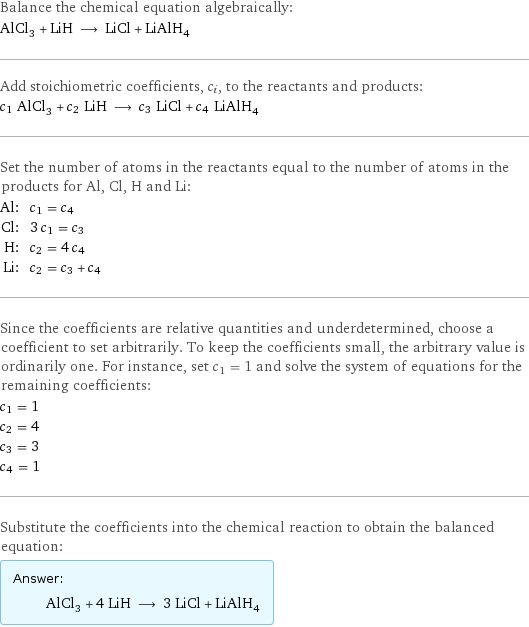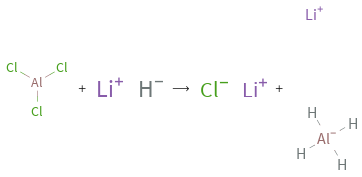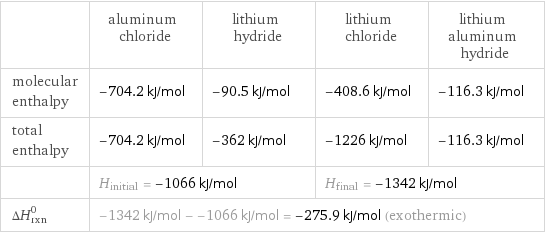Input interpretation

AlCl_3 aluminum chloride + LiH lithium hydride ⟶ LiCl lithium chloride + LiAlH_4 lithium aluminum hydride
Balanced equation

Balance the chemical equation algebraically: AlCl_3 + LiH ⟶ LiCl + LiAlH_4 Add stoichiometric coefficients, c_i, to the reactants and products: c_1 AlCl_3 + c_2 LiH ⟶ c_3 LiCl + c_4 LiAlH_4 Set the number of atoms in the reactants equal to the number of atoms in the products for Al, Cl, H and Li: Al: | c_1 = c_4 Cl: | 3 c_1 = c_3 H: | c_2 = 4 c_4 Li: | c_2 = c_3 + c_4 Since the coefficients are relative quantities and underdetermined, choose a coefficient to set arbitrarily. To keep the coefficients small, the arbitrary value is ordinarily one. For instance, set c_1 = 1 and solve the system of equations for the remaining coefficients: c_1 = 1 c_2 = 4 c_3 = 3 c_4 = 1 Substitute the coefficients into the chemical reaction to obtain the balanced equation: Answer: | | AlCl_3 + 4 LiH ⟶ 3 LiCl + LiAlH_4
Structures

+ ⟶ +
Names

aluminum chloride + lithium hydride ⟶ lithium chloride + lithium aluminum hydride
Reaction thermodynamics
Enthalpy

| aluminum chloride | lithium hydride | lithium chloride | lithium aluminum hydride molecular enthalpy | -704.2 kJ/mol | -90.5 kJ/mol | -408.6 kJ/mol | -116.3 kJ/mol total enthalpy | -704.2 kJ/mol | -362 kJ/mol | -1226 kJ/mol | -116.3 kJ/mol | H_initial = -1066 kJ/mol | | H_final = -1342 kJ/mol | ΔH_rxn^0 | -1342 kJ/mol - -1066 kJ/mol = -275.9 kJ/mol (exothermic) | | |
Gibbs free energy

| aluminum chloride | lithium hydride | lithium chloride | lithium aluminum hydride molecular free energy | -628.8 kJ/mol | -68.3 kJ/mol | -384.4 kJ/mol | -44.7 kJ/mol total free energy | -628.8 kJ/mol | -273.2 kJ/mol | -1153 kJ/mol | -44.7 kJ/mol | G_initial = -902 kJ/mol | | G_final = -1198 kJ/mol | ΔG_rxn^0 | -1198 kJ/mol - -902 kJ/mol = -295.9 kJ/mol (exergonic) | | |
Equilibrium constant
![Construct the equilibrium constant, K, expression for: AlCl_3 + LiH ⟶ LiCl + LiAlH_4 Plan: • Balance the chemical equation. • Determine the stoichiometric numbers. • Assemble the activity expression for each chemical species. • Use the activity expressions to build the equilibrium constant expression. Write the balanced chemical equation: AlCl_3 + 4 LiH ⟶ 3 LiCl + LiAlH_4 Assign stoichiometric numbers, ν_i, using the stoichiometric coefficients, c_i, from the balanced chemical equation in the following manner: ν_i = -c_i for reactants and ν_i = c_i for products: chemical species | c_i | ν_i AlCl_3 | 1 | -1 LiH | 4 | -4 LiCl | 3 | 3 LiAlH_4 | 1 | 1 Assemble the activity expressions accounting for the state of matter and ν_i: chemical species | c_i | ν_i | activity expression AlCl_3 | 1 | -1 | ([AlCl3])^(-1) LiH | 4 | -4 | ([LiH])^(-4) LiCl | 3 | 3 | ([LiCl])^3 LiAlH_4 | 1 | 1 | [LiAlH4] The equilibrium constant symbol in the concentration basis is: K_c Mulitply the activity expressions to arrive at the K_c expression: Answer: | | K_c = ([AlCl3])^(-1) ([LiH])^(-4) ([LiCl])^3 [LiAlH4] = (([LiCl])^3 [LiAlH4])/([AlCl3] ([LiH])^4)](../image_source/ad4286d6d02ceec4c3d817d1d9a038c0.png)
Construct the equilibrium constant, K, expression for: AlCl_3 + LiH ⟶ LiCl + LiAlH_4 Plan: • Balance the chemical equation. • Determine the stoichiometric numbers. • Assemble the activity expression for each chemical species. • Use the activity expressions to build the equilibrium constant expression. Write the balanced chemical equation: AlCl_3 + 4 LiH ⟶ 3 LiCl + LiAlH_4 Assign stoichiometric numbers, ν_i, using the stoichiometric coefficients, c_i, from the balanced chemical equation in the following manner: ν_i = -c_i for reactants and ν_i = c_i for products: chemical species | c_i | ν_i AlCl_3 | 1 | -1 LiH | 4 | -4 LiCl | 3 | 3 LiAlH_4 | 1 | 1 Assemble the activity expressions accounting for the state of matter and ν_i: chemical species | c_i | ν_i | activity expression AlCl_3 | 1 | -1 | ([AlCl3])^(-1) LiH | 4 | -4 | ([LiH])^(-4) LiCl | 3 | 3 | ([LiCl])^3 LiAlH_4 | 1 | 1 | [LiAlH4] The equilibrium constant symbol in the concentration basis is: K_c Mulitply the activity expressions to arrive at the K_c expression: Answer: | | K_c = ([AlCl3])^(-1) ([LiH])^(-4) ([LiCl])^3 [LiAlH4] = (([LiCl])^3 [LiAlH4])/([AlCl3] ([LiH])^4)